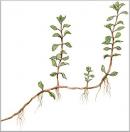Hampshire Purslane - Ludwigia palustris
Small herbaceous aquatic plant, from five to fifty centimetres long with creeping stem rooting at the nodes, or otherwise floating.
The green or brownish, glabrous and slightly fleshy leaves are opposite, with short stalks. The floating leaves have a lanceolate blade, the others are elliptical or ovate.
The name of the genus was given by Linneus, in honour of his contemporary, Ludwig, a German Naturalist.
Perhaps more than any other aquatic plant, Ludwigia palustris has suffered greatly from the reduction and transformation of the habitats suitable for its way of life and from water pollution.
The latter in particular has been responsible for its decline in northern Italy and its falling numbers in the few stations where it has been reported in the Peninsular and Sardinia.
It does occur at Sibolla, Fucecchio and Bientina and is locally abundant. At Cerbaie, several square metres of "meadows" of the plant can be admired just under the water surface in some artificial pools.
The tangle of leaves and flexible stems of this graceful plant offer refuge and food to fish and molluscs and a hiding place for insect larvae, whilst Green Frogs and Newts go there to lay their jelly-like spawn.




